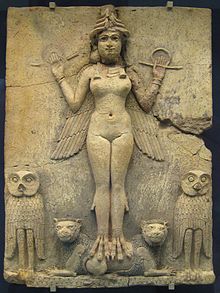Burney Relief

A likely representation of either Ereshkigal or Ishtar
|
|
| Material | Clay |
|---|---|
| Size | Height: 49.5 cm (19.5 in) Width: 37 cm (15 in) Thickness: 4.8 cm (1.9 in) |
| Created | 19th-18th century BCE |
| Period/culture | Old Babylonian |
| Place | Made in Babylonia |
| Present location | Room 56, British Museum, London |
| Identification | Loan 1238 |
| Registration | 2003,0718.1 |
The Burney Relief (also known as the Queen of the Night relief) is a Mesopotamian terracotta plaque in high relief of the Isin-Larsa- or Old-Babylonian period, depicting a winged, nude, goddess-like figure with bird's talons, flanked by owls, and perched upon two lions. The relief is displayed in the British Museum in London, which has dated it between 1800 and 1750 BCE. It originates from southern Mesopotamia, but the exact find-site is unknown. Apart from its distinctive iconography, the piece is noted for its high relief and relatively large size, which suggest that it was used as a cult relief, making it a very rare survival from the period. However, whether it represents Lilitu, Inanna/Ishtar, or Ereshkigal is under debate. The authenticity of the object has been questioned from its first appearance in the 1930s, but opinion has generally moved in its favour over the subsequent decades.
Initially in the possession of a Syrian dealer, who may have acquired the plaque in southern Iraq in 1924, the relief was deposited at the British Museum in London and analysed by Dr. H.J. Plenderleith in 1933. However, the Museum declined to purchase it in 1935, whereupon the plaque passed to the London antique dealer Sidney Burney; it subsequently became known as the "Burney Relief". The relief was first brought to public attention with a full-page reproduction in The Illustrated London News, in 1936. From Burney, it passed to the collection of Norman Colville, after whose death it was acquired at auction by the Japanese collector Goro Sakamoto. British authorities, however, denied him an export licence. The piece was loaned to the British Museum for display between 1980 and 1991, and in 2003 the relief was purchased by the Museum for the sum of £1,500,000 as part of its 250th anniversary celebrations. The Museum also renamed the plaque the "Queen of the Night Relief". Since then, the object has toured museums around Britain.
...
Wikipedia
